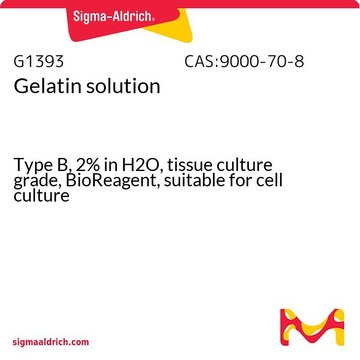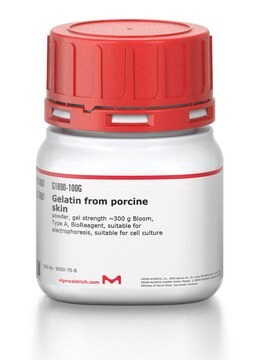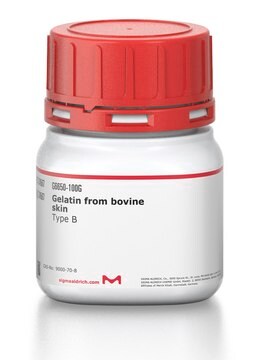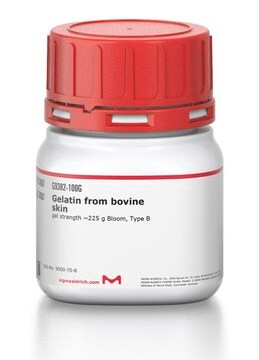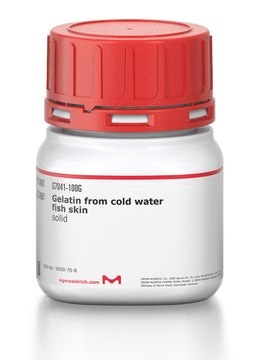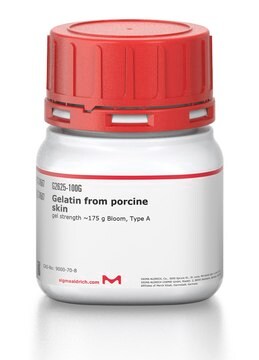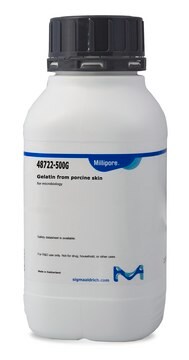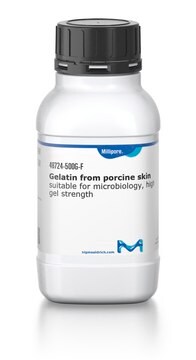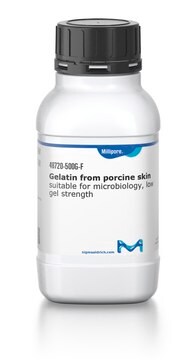G9391
Bovine Gelatin
from bovine skin, Type B, powder, suitable for cell culture
About This Item
Prodotti consigliati
product name
Gelatin from bovine skin, Type B, powder, BioReagent, suitable for cell culture
Origine biologica
bovine skin
Livello qualitativo
Sterilità
sterile
Tipo
Type B
Nome Commerciale
BioReagent
Forma fisica
powder
Confezionamento
pkg of 100 g
pkg of 500 g
tecniche
cell culture | mammalian: suitable
Resistenza del gel
~225 g Bloom
Solubilità
H2O: soluble 50 mg/mL, hazy to strongly hazy, faintly yellow to yellow
Condizioni di spedizione
ambient
Temperatura di conservazione
room temp
Cerchi prodotti simili? Visita Guida al confronto tra prodotti
Descrizione generale
Applicazioni
- in coating cell culture to improve attachment of cells,
- in PCR to stabilize Taq DNA, as a blocking reagent in Western blotting, ELISA, and immunochemistry,
- as a component of media for species differentiation in bacteriology
- as a biocompatible polymer
- as a delivery vehicle for the release of active biomolecules
- in the generation of scaffolds for tissue engineering applications.
- to study long-chain fatty acid-induced changes in gene expression in neonatal cardiac monocytes
- to study to test mobilization of capillary endothelium in-vitro induced by effectors of angiogenesis in vivo
Azioni biochim/fisiol
Componenti
Avvertenza
Nota sulla preparazione
Codice della classe di stoccaggio
11 - Combustible Solids
Classe di pericolosità dell'acqua (WGK)
nwg
Punto d’infiammabilità (°F)
Not applicable
Punto d’infiammabilità (°C)
Not applicable
Dispositivi di protezione individuale
Eyeshields, Gloves, type N95 (US)
Certificati d'analisi (COA)
Cerca il Certificati d'analisi (COA) digitando il numero di lotto/batch corrispondente. I numeri di lotto o di batch sono stampati sull'etichetta dei prodotti dopo la parola ‘Lotto’ o ‘Batch’.
Possiedi già questo prodotto?
I documenti relativi ai prodotti acquistati recentemente sono disponibili nell’Archivio dei documenti.
I clienti hanno visto anche
Articoli
Attachment Factors for 3-Dimensional Cell Culture
The extracellular matrix (ECM) is secreted by cells and surrounds them in tissues.
Cancer stem cell media, spheroid plates and cancer stem cell markers to culture and characterize CSC populations.
Il team dei nostri ricercatori vanta grande esperienza in tutte le aree della ricerca quali Life Science, scienza dei materiali, sintesi chimica, cromatografia, discipline analitiche, ecc..
Contatta l'Assistenza Tecnica.
